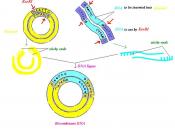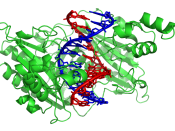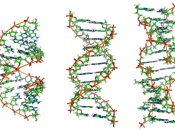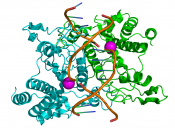Gene Technology Genetic engineering is possibly the fastest growing field of biology. Genetic engineering is defined as the process of isolating a gene from the DNA of one organism and transferring the gene into the DNA of another. Many experiments have been performed in this field but the most notable and precedent experiment came in 1973 by biochemists Stanley Cohen and Herbert Boyer. The two men were determined to create the fist genetically engineered organism by taking a gene from the from Xenopus laevis and inserting it into the DNA of Escherichia coli. The process included 4 steps: cleaving the DNA, producing recombinant DNA, cloning cells and finally screening cells. The first step, cleaving DNA is a procedure where restriction enzymes cut DNA fragments from a double helix, later placing the fragments into a plasmid which will serve as a vector, thus being the third step in the procedure. The restriction enzyme used by Cohen and Boyer is entitled EcoR1.
This enzyme identifies the sequence GAATTC and makes incisions to the DNA and the plasmid. However, before the fragment can be added, DNA ligase must be supplemented to seal the endings. The following step includes introducing a culture of bacteria with the vectors that include the DNA fragments. The cells that take in the vectors are segregated from the rest and are allowed to reproduce. This reproduction of identical cells is called cloning. Screening later takes place to exactly identify the cells that have acquired the "genes of interest". Analysis was then needed to test the remaining cells to see if they actually contained the recombinant DNA. A technique called the Southern blot is a useful tool in conducting this test. A probe which consists of RNA that is radioactive or single stranded DNA, later help identify the specific genes. A cloned DNA molecule is separated into fragments using restriction enzymes. The fragments are later separated again using gel electrophoresis, which uses a gel and electrical field to organize them into configuration of "bands"ÃÂ. After another procedure the fragments are arranged on to filter paper containing the probes, if a fragment contains this "gene of interest"ÃÂ it will bind to the probes.
Many great benefits can result from the latest advances in gene technology. If the findings were to be used in plants, many solutions to certain problems the world is currently facing could be resolved. For example transgenic organisms could yield bigger and taller plants or even produce greater quantities of crops in counties where food is needed most. Genetic engineering can also make plants more resistant to certain diseases thus yielding more abundant quantities. Other interesting ideas included attempts to make plants require less significant amounts of water. This concept could be quite helpful where there is drought, or other forms of water dearth. The possibilities of genetic engineering are endless, however there is much opposition to limitless potential of this branch of science. Many argue that mass production of genetically altered food could be unsafe or dangerous. Others say that major companies would patent certain genetically engineered seeds making poor farmers unable to afford to grow certain crops thus creating many complicating issues with biopiracy. Overall, the effects of genetic engineering could be quite positive however new advances must be strictly controlled to avoid any safety or ethical issues.





